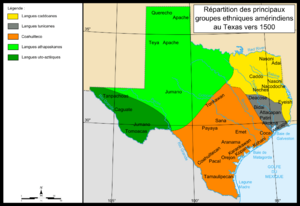Payaya people facts for kids
The Payaya people were a group of Native Americans who lived in what is now San Antonio, Texas. They were part of a larger group called the Coahuiltecan people. The Payaya are known as the first people to live in the area that became San Antonio, especially around San Pedro Springs Park.
Contents
Where Did the Payaya Live?
The Payaya people lived in different parts of Texas. Their lands included the area around the San Antonio River. They also lived near the Frio River to the west, close to the lands of the Pastia people. To the east, they lived in what is now Milam County, alongside the Tonkawa people.
Their Village: Yanaguana
The Payaya called their main village Yanaguana. This village was located right next to a river. The Spanish later named this river the San Antonio River. Some people think the Payaya might have called the river itself Yanaguana. However, a Spanish priest named Damián Massanet wrote in his diary that Yanaguana was the name of their village.
First Contact with Europeans
The Payaya first met Spanish explorers and settlers in the 1600s. At that time, the Payaya had about ten different camps or settlements.
By 1706, some Payaya people had become part of a Spanish mission. This was Mission San Francisco Solano, located about 5 miles from the Rio Grande in Coahuila, Mexico. Today, the town of Guerrero is near where this mission once stood. By 1709, the Payaya were a smaller group, with about sixty families.
Life at the Mission
In 1716, the Payaya became friends with a Franciscan priest named Antonio de Olivares. They later joined the San Antonio de Valero Mission, which was started in 1718. This mission is now famous as the Alamo.
At the mission, the Spanish tried to help the Payaya learn new ways of life. They taught them Spanish and useful trade skills. The Payaya people also had their own elected leaders within the mission. Sadly, many Payaya at the mission became sick with diseases from Europe. These diseases caused many deaths during the 1700s.
Payaya Culture and Daily Life
Like other Coahuiltecan groups, the Payaya were a hunter-gatherer society. This means they found their food by hunting animals and gathering plants. The Spanish wrote about how the Payaya collected nuts. Historians believe that pecans were a very important food for the Payaya. This is because the Payaya often moved around the Edwards Plateau, where pecans grow.
What the Spanish Saw
Father Damián Massanet wrote about his experiences with the Payaya in his diary on June 13, 1691. He described them as friendly towards the Spanish. However, he also noted that they could be warlike among themselves.
Massanet wrote about a tribal war dance. He also mentioned that the Payaya wore clothes made from deerskin. They were known for taking horses and women from other groups. Massanet also said that the Payaya were good at learning Spanish. They also seemed to like Spanish clothing.
Massanet also observed that the Payaya had respect for a higher spiritual power. He noted that they had put up a wooden cross in their village. The day after the Spanish arrived, Massanet and his group celebrated a Mass for the Feast of Corpus Christi. The Payaya people were there to watch.
Payaya Language
Quick facts for kids Payaya |
|
|---|---|
| Native to | Texas |
| Era | 18th century |
| Language family |
unclassified
|
Not much is known about the Payaya language. There isn't enough information to fully understand or classify it today.


